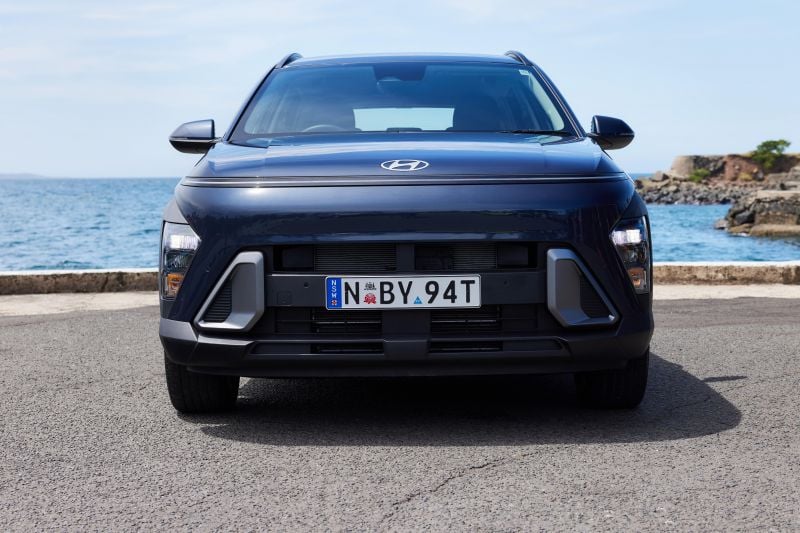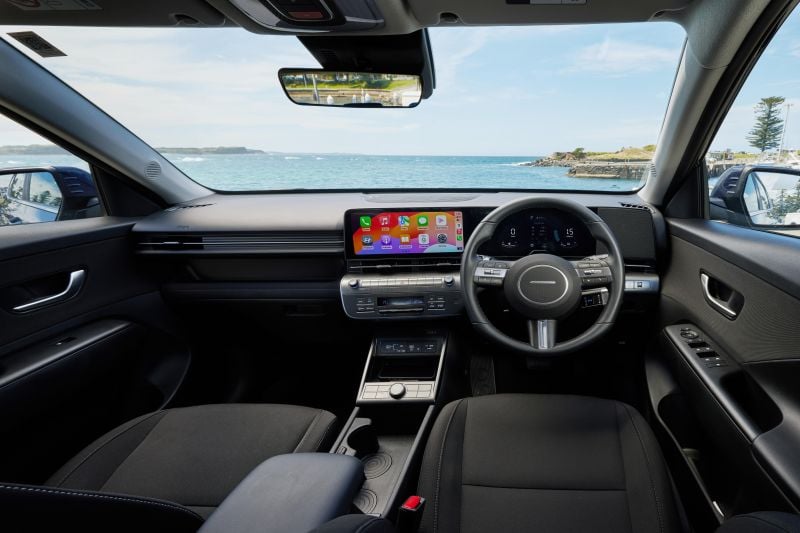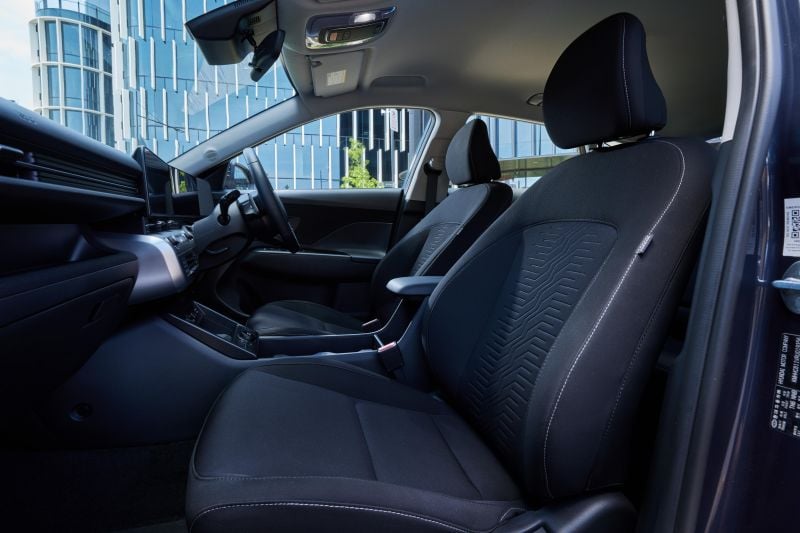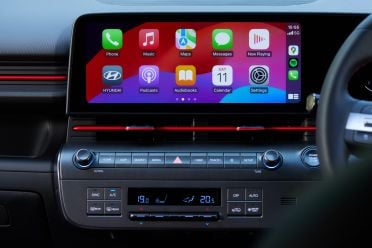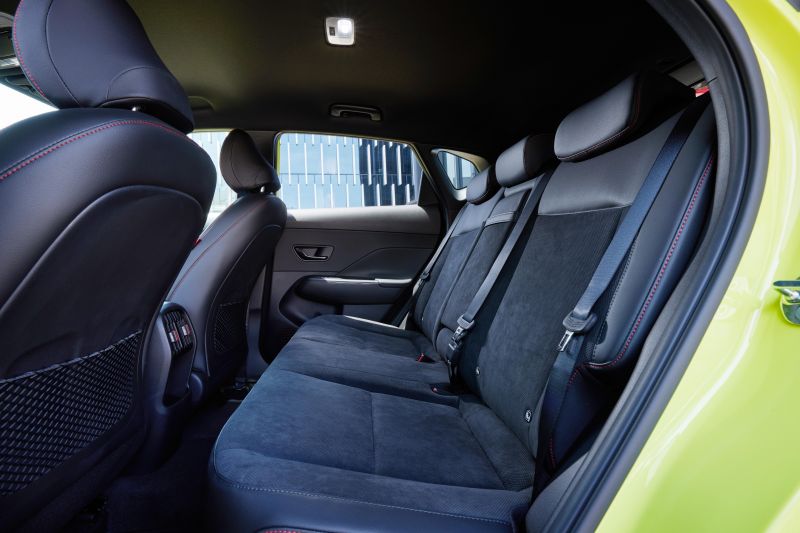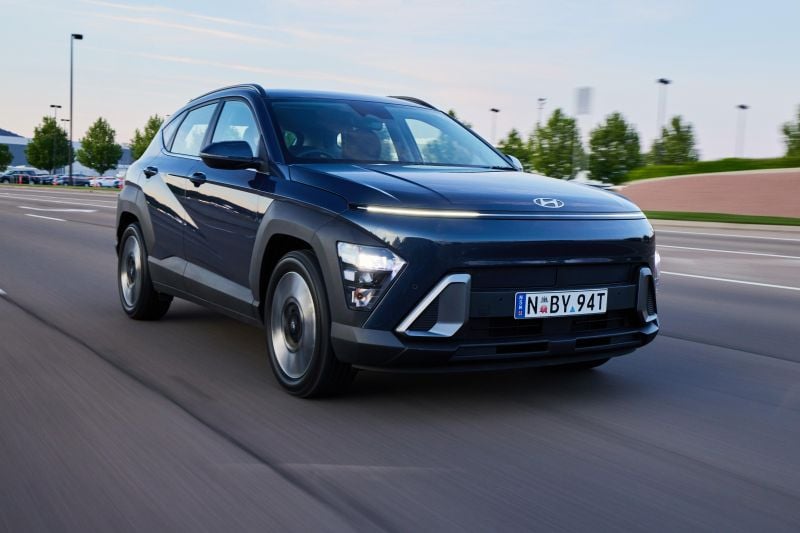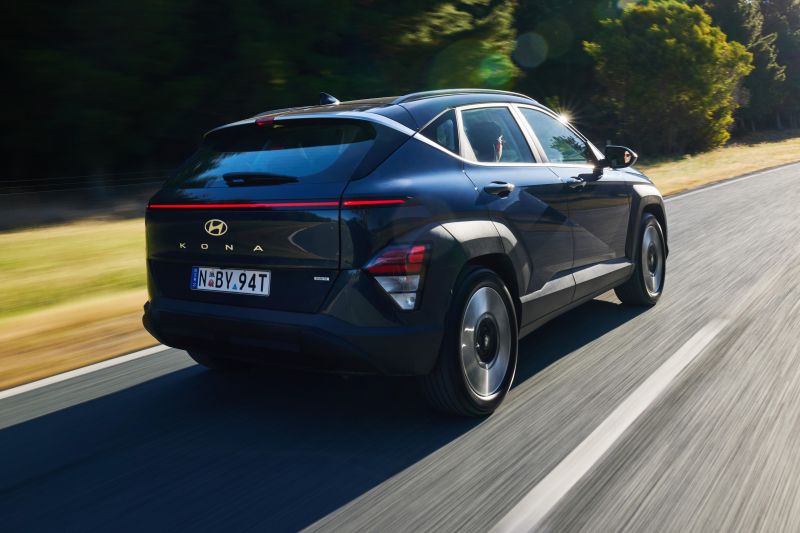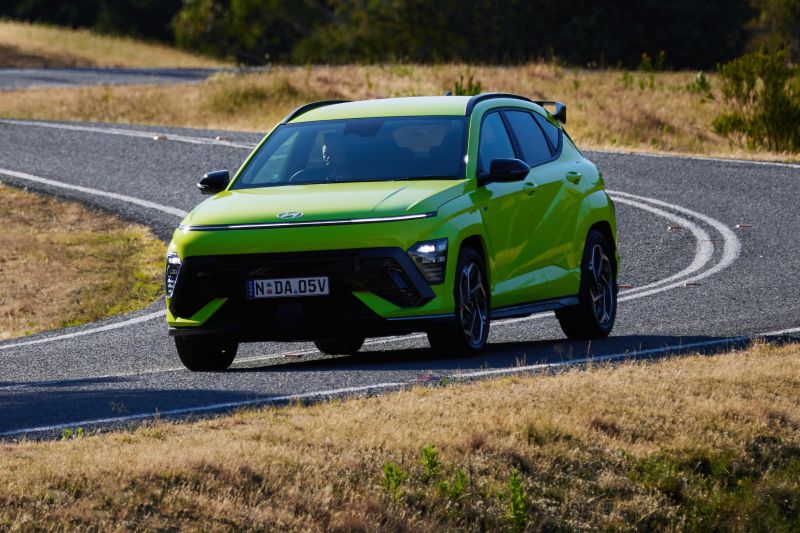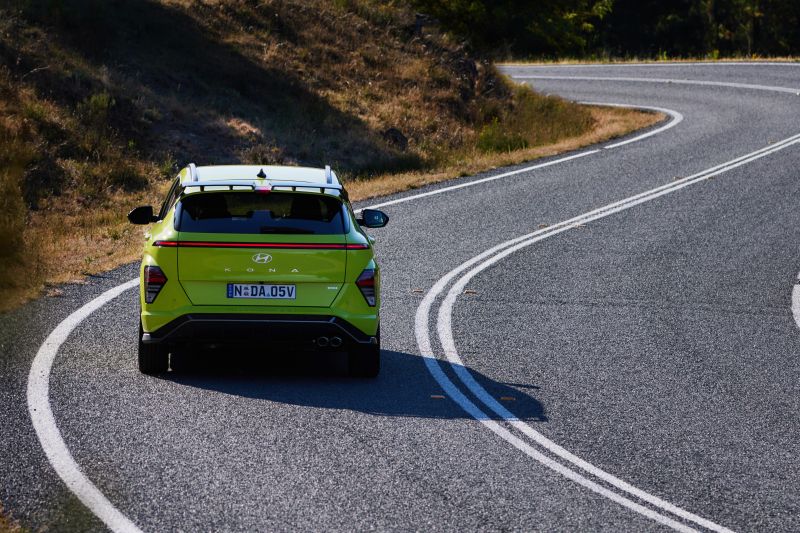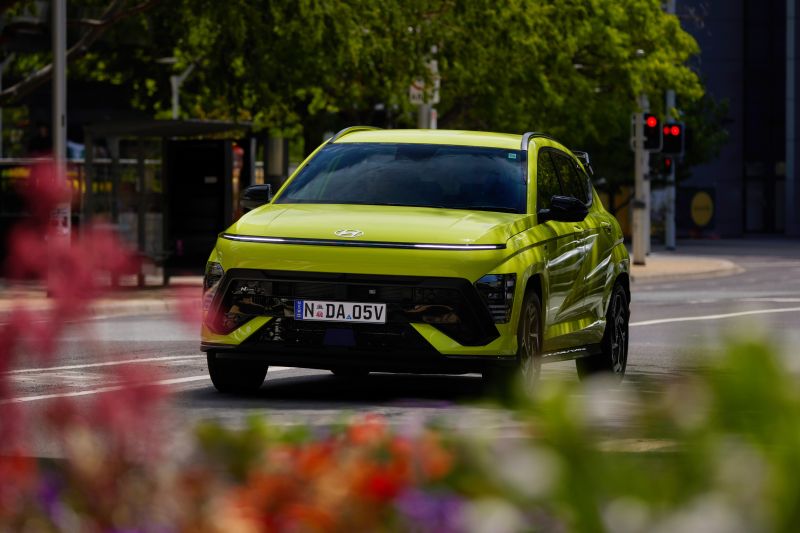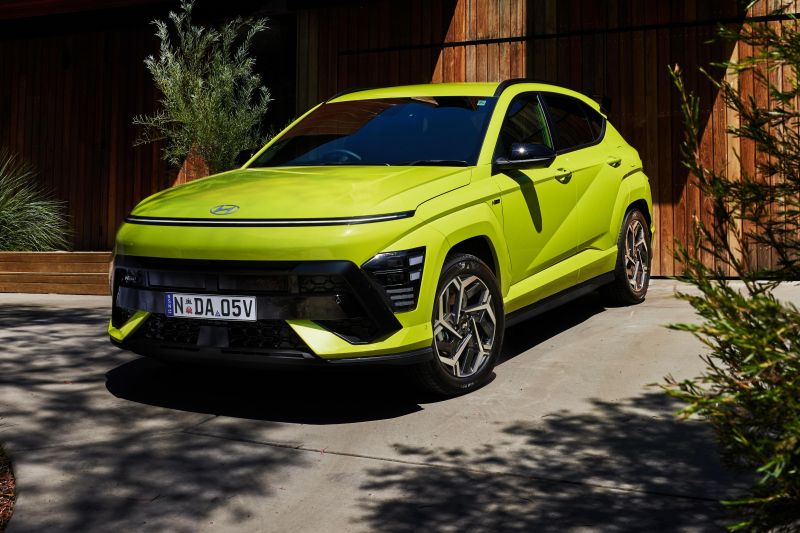Hyundai is getting its act together on hybrids.
Although it can’t match market leader Toyota when it comes to outright variety, by the middle of 2024 it’ll offer hybrid versions of its i30 Sedan, Tucson mid-sized SUV, Santa Fe seven-seater, and the Kona you see here.
You’re able to have a 2024 Hyundai Kona Hybrid (HEV) in any trim level you like, and it carries no price premium relative to the turbocharged 1.6-litre petrol engine sitting alongside it in the range. Hyundai is even forecasting solid supply.
On paper, the Kona Hybrid has all the makings of a strong seller. How does it stack up in the real world?
How does the Hyundai Kona fare vs its competitors?
View a detailed breakdown of the Hyundai Kona against similarly sized vehicles.

Hyundai
Kona
How much does the Hyundai Kona Hybrid cost?
2024 Hyundai Kona pricing:
- Hyundai Kona
- 2.0 petrol: $32,000
- 1.6 hybrid: $36,000
- Hyundai Kona N Line
- 1.6 hybrid: $40,000
- 1.6T AWD: $40,000
- Hyundai Kona Premium
- 2.0 petrol: $39,500
- 1.6 hybrid: $43,500
- Hyundai Kona N Line Premium
- 1.6 hybrid: $46,500
- 1.6T AWD: $46,500
All prices exclude on-road costs
What is the Hyundai Kona Hybrid like on the inside?
The biggest issue with the last Kona was a lack of space inside. The new model resoundingly addresses the problem.
It looks and feels significantly more grown up up front, and there’s finally enough room in the rear to comfortably carry adults behind adults. Like the Kia Seltos and latest Nissan Qashqai, it feels more like a smaller mid-sized SUV than a grown-up compact.
It’s also much more modern up front, with a version of the dual-screen display rolling out across the Kia and Hyundai ranges. Even base cars get a high-resolution 12.3-inch central display and a smartly-integrated ‘basic’ digital speedo, while higher-end models have dual 12.3-inch screens.
The software is easy enough to use, and touches such as the move to put the shortcut buttons in the bottom right-hand corner of the screen instead of the top left make life easier in right-hand drive Australia.
We know wireless Apple CarPlay and Android Auto are coming with a software update, but for now cars with factory satellite navigation don’t have it. It remains a frustrating omission.
Although the basic dials are neat enough, the digital dash offered in higher-end models does liven the cabin up. In the N Line, flicking into Sport gives you a red-and-white kerb outline around the rev counter and speedo… although we’d still like to see more customisation potential, as is offered in Volkswagen Group products.
Presentation is impressive across the range. The clean design looks flashy, and features like dual-zone climate control even on base models go some way to justifying part of the price.
Credit to Hyundai for sticking with physical buttons and dials for the climate controls and drive mode. It’s easy to flick into Sport, for example, or knock the temperature up by one degree without taking your eyes off the road, as should be the case.
The flip side? There’s still lots of cheap, hard plastics, from the sides of the dashboard to the top of the doors.
Unlike the base petrol, which gets a basic transmission tunnel with an old-school t-bar shifter, even the cheapest hybrid has the more upscale open centre console. It has acres of storage space, and looks suitably clean and modern alongside the dull as dishwater Toyota Corolla Cross.
Jumping to the N Line brings plenty of red highlights and a lovely set of seats that go a long way towards lifting the ambience, while the Premium gains leather and a more advanced infotainment system with built-in navigation.
There’s a noticeable step up in either N Line or Premium guises.
Rear seat space is miles better in this Kona than the last, starting with the wider-opening doors.
Adults don’t need to contort themselves to squeeze in anymore, which is a step forward, and once back there you get levels of legroom and headroom comparable to a Kia Seltos. It’s more Tucson-lite than bigger Venue, making this a more suitable car for young families than ever.
The air vents and USB-C ports are family-friendly touches, and the broader rear bench will keeping warring kids at bay more effectively than before.
ISOFIX on the outboard seats and a trio of top-tether points are present, as is a fold-down central armrest.
Boot space in the Kona has improved from 374L to 407L with the arrival of the larger new second-generation car here. With the rear seats folded there’s 1241L of space.
It’s a much more usable space than before, with a height-adjustable floor and a slot at the back of the boot to store the luggage cover.
What’s under the bonnet?
New for Australia is a hybrid powertrain in the Kona. It combines a 1.6-litre naturally aspirated petrol engine with an electric motor, hooked up to a 1.32kWh battery pack.
The electric motor makes 32kW of power and 172Nm of torque; combined system outputs are 104kW and 265Nm. It’s hooked up to a six-speed dual-clutch transmission.
Claimed fuel economy is a miserly 3.9 litres per 100km on the combined cycle. We saw 5.7 litres per 100km on a run through the hills outside Canberra.
The fuel tank holds 38 litres, and the Kona Hybrid happily drinks 91 RON regular unleaded.
How does the Hyundai Kona Hybrid drive?
Hyundai’s hybrid system is different to Toyota’s, with a feeling that’ll be more conventional to anyone hopping out of an old car.
It defaults to electric power at low speeds, before the petrol engine kicks in at around 20-30km/h and offers a helping hand. That makes for smooth, quiet progress in crawling traffic, where the petrol engine is rarely required.
When it does kick in, the petrol engine has been refined relative to the equivalent system in older Hyundai products. It fires quietly, and you don’t get the pronounced and awkward “handover” feeling that sometimes afflicts hybrids.
At times it’s hard to know whether you’re running on electric or petrol power, or a combination of both.
Put your foot down and you don’t get the awkward slurring present in hybrid cars with CVT automatics. Hyundai uses a dual-clutch transmission, and when you accelerate the car runs through the gears in a way that’ll feel familiar to most drivers.
Having the electric motor on hand also smooths out some of the awkwardness that remains in Hyundai dual-clutch transmissions at low speeds. Where it can feel a bit disjointed in petrol-only cars, there’s no jerking or stuttering in away from the mark.
Like the petrol model, the hybrid tiptoes the tricky tightrope between control and comfort remarkably well for a (relatively) affordable, (relatively) compact SUV on the open road.
Even the base model feels nicely planted at high speeds, more like a shrunken Tucson than a grown-up i30, soaking up pockmarked Australian country roads better than you’d expect. There’s no noise from the wing mirrors or windscreen pillars, but you do get a healthy dose of road roar from the tyres on coarse-chip roads.
We didn’t spend any time in the city in the hybrid, but our experience of the regular model shows it’s generally nice and comfortable, although it can crash and bash over big potholes and bumps.
If you like driving, there’s some fun to be had in the N Line. It doesn’t go as far as the previous-generation Kona N, but there’s definitely a sportier bent that will please keen drivers.
Keen drivers will want a bit more punch, though. The hybrid has more than enough performance for life in the city, but it feels a bit underdone if you spend lots of time on the highway. Put your foot down to overtake and you get plenty of noise (it’s the only time this engine really makes its presence known), but very little extra shove.
Overtakes take a heavy right foot and a decent run-up. This isn’t pitched as the performance option in the Kona range, so it’s not a deal breaker, but it’s worth bearing in mind if you live in the country.
The adaptive cruise control does a good job maintaining a gap to the car in front, and the lane-keeping assist decisively nudges you back between the white lines if you stray.
Hyundai’s lane-centring system, which more actively controls the car’s position in the lane rather than intervening when you stray, is a bit too hands-on for my liking, though.
The driver attention monitoring is also prone to false positives, flashing when you actually are looking at the road… which makes you look away. More refinement is needed.
What do you get?
Kona highlights:
- 18-inch alloy wheels with 215/55 tyres
- LED headlights and daytime running lights
- LED tail lights
- Heated, power-folding exterior mirrors
- Keyless entry and start
- Dual-zone climate control
- Rear air vents
- 4.2-inch digital instrument display
- 12.3-inch infotainment touchscreen
- Apple CarPlay and Android Auto
- Bluelink connected services
Kona Premium adds:
- Blind Spot View Monitor
- Reverse autonomous emergency braking
- 3D surround-view camera
- Side parking sensors
- Acoustic front windscreen
- Rear privacy glass
- Dark grey cladding/silver skid plates
- LED dual-projector headlights
- LED front/rear indicators
- ‘Seamless Horizon’ full-width LED front light strip
- Power tailgate
- 12.3-inch digital instrument cluster
- Factory satellite navigation
- Bose eight-speaker sound system
- Leather upholstery
- 10-way power driver’s seat
- 8-way passenger seat
- Premium relaxation front seats
- Heated/ventilated front seats
- Heated steering wheel
- Heated rear seats
- Auto-dimming interior mirror
- Rain-sensing wipers
- Ambient lighting
- Leather-appointed door trim inserts, door armrests, dashboard tray
N Line Package brings:
- Unique bumpers/skid plates/side skirts
- Gloss black rear spoiler
- N badging/wheel caps
- 19-inch wheels with 235/45 tyres (18in HEV)
- Chrome twin exhaust
- Black mirror caps/beltline
- Body coloured cladding
- Leather/Alcantara trim
- N steering wheel
- Red air vents/seat highlights
- Dark metal trim highlights
- Black headlining
- Alloy pedals
- Sports scuff plates
Is the Hyundai Kona Hybrid safe?
The Hyundai Kona hasn’t been crash tested.
Standard safety equipment includes:
- 7 airbags incl. front-centre
- AEB incl. Pedestrian, Cyclist detection
- AEB rear
- Driver attention monitoring
- Blind-spot monitoring and assist
- Lane keep assist
- Safe exit warning
- Parking sensors
How much does the Hyundai Kona Hybrid cost to run?
The Hyundai Kona is backed by a five-year, unlimited-kilometre warranty.
Maintenance is required every 12 months or 15,000 kilometres, and the first five services each cost $399.
CarExpert’s Take on the Hyundai Kona Hybrid
The petrol Kona is already a good thing, and the addition of a hybrid model has broadened its appeal even further.
We’ll have to spend more time behind the wheel in the city to really hone in on how it compares with the Toyota Corolla Cross, but the Hyundai shapes as a compelling alternative.
Like the petrol it’s modern and spacious behind the wheel, and drives with some real polish. It’s been a long time coming, but the Kona Hybrid is poised to make an impact in Australia.
Click the images for the full gallery
BUY: Hyundai Kona
MORE: Everything Hyundai Kona

